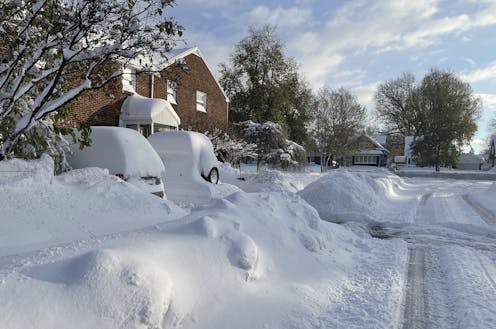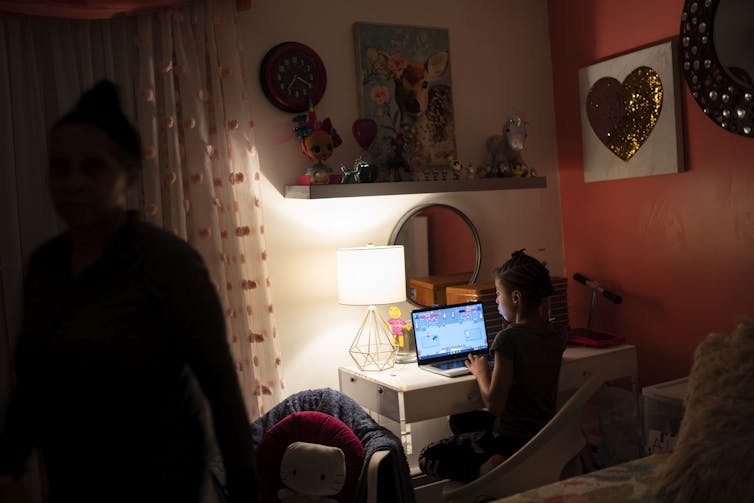
Snow days, a nostalgic rite of passage for generations of students across the northern United States, might seem destined to be a memory of school days past. For nearly a century, schools have canceled or delayed classes because of heavy or dangerous snowfall that creates hazardous travel conditions. School calendars would include a number of “makeup” days, when any missed time could be rescheduled.
During the COVID-19 pandemic, schools transitioned to remote learning to keep teaching when it wasn’t safe for people to gather. With students already learning at home, nearly 40% of schools chose to forgo traditional snow days and proceed with remote learning during the pandemic. Those choices, and improvements in online education, led several commentators to predict the end of the snow day.
However, policy data collected from the 35 states with the highest average annual snowfall suggests that while more schools are using remote learning days instead of canceling classes, the traditional snow day is far from extinct.
Snow days seem to be sticking around, thanks to nostalgia, lingering concerns about the effectiveness and accessibility of online learning and a sentiment that families and children need these unscripted, unplugged breaks.
A new option becomes available
When schools close because of inclement weather, it affects students’ learning.
For instance, research in Colorado, Maryland and Virginia has shown that each additional inch of snow led to less continuity of learning, which in turn made it less likely that elementary school students would pass math assessments.
Even before the pandemic, 14 states had policies that allowed schools other options besides closing for inclement weather. Beginning in 2011, Kentucky, New Hampshire, Kansas, Missouri and West Virginia allowed students to work on preassembled packets that had been prepared and sent home instead of calling a snow day.
As technology improved, schools replaced take-home packets with online assignments and instruction.
In 2017, Minnesota authorized five e-learning days a year. Illinois followed suit in 2019. In Pennsylvania, 85% of public school districts can take advantage of a 2019 policy that allows five days of remote instruction.
During the pandemic years, more schools got better at teaching online and saw opportunities to reduce school closings during winter storms. With nearly all states authorized on public health grounds to provide remote instruction during COVID-19, schools began doing so for inclement weather, too.
In 2022, the New York Board of Regents authorized the state’s public schools to teach remotely instead of canceling class on snow days. Days earlier, anticipating the decision, New York City Schools Chancellor David Banks announced: “If a snow day comes around, we want to make sure that our kids continue to learn,” adding, “so, sorry kids! No more snow days, but it’s gonna be good for you!”
Seven other states updated their laws to allow remote learning. For example, Maryland now allows up to eight days a year of remote learning – so long as five of those days include live sessions with a teacher – and Virginia’s new law allows 10 days.
By the start of the 2022-2023 school year, over three-quarters of snowy states had policies in place to significantly curtail school closures, keep students learning and prevent makeup days from stretching the school year into the summer. That’s up from half of them in the 2018-2019 school year.

For now: A wintry mix of snow days and remote learning
Within those states that allow remote learning for inclement weather, schools have actually followed three different patterns: full online transition, preserving traditional snow days or a combination of both.
Relatively few school systems – typically in metro areas like St. Paul or St. Louis – have followed New York City’s lead in announcing plans to move completely online during what would otherwise be snow days. There are also many school districts in very snowy locales – like New York’s snowiest district of Syracuse – that will not be using remote learning days.
However, the most common approach across the nation will be a mix of remote learning and snow days depending on local conditions. For example, in Baltimore, the superintendent announced that remote learning would be used under the new Maryland policy only “as a last resort” after the five makeup days in the calendar were exhausted. In West Virginia, schools will use a portion of their allotted nontraditional instruction days but reserve an “old-fashioned snow day” for students.
The nostalgic sentiment for preserving the snow day tradition was epitomized in a viral post from Jefferson County, West Virginia, Superintendent Bondy Shay Gibson, who declared on the first snow day of last year that school would be “closed for students … closed for virtual … closed for staff.” She said, “For generations, families have greeted the first snow day of the year with joy. … It is a time of renewed wonder at all the things that each season holds. A reminder of how fleeting a childhood can be. An opportunity to make memories with your family that you will hold onto for life.”
For many families this winter, the possibility of a snow day remains. When the first major storm of the 2022 winter season bore down on western New York with as much as 6 feet of snow, students in the region waited anxiously for pending school decisions: Buffalo Public Schools chose to shift to remote learning, but neighboring Niagara Falls canceled.
The day may well come when remote learning replaces snow days. But for now, children can continue with rituals to flush ice cubes down the toilet, wear pajamas inside-out and place spoons under their pillows – and hope not only for a snow day, but for a day without remote learning too.
Nathan M. Sorber does not work for, consult, own shares in or receive funding from any company or organization that would benefit from this article, and has disclosed no relevant affiliations beyond their academic appointment.
This article was originally published on The Conversation. Read the original article.







